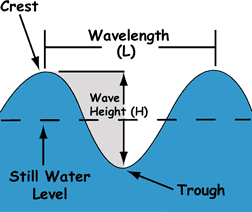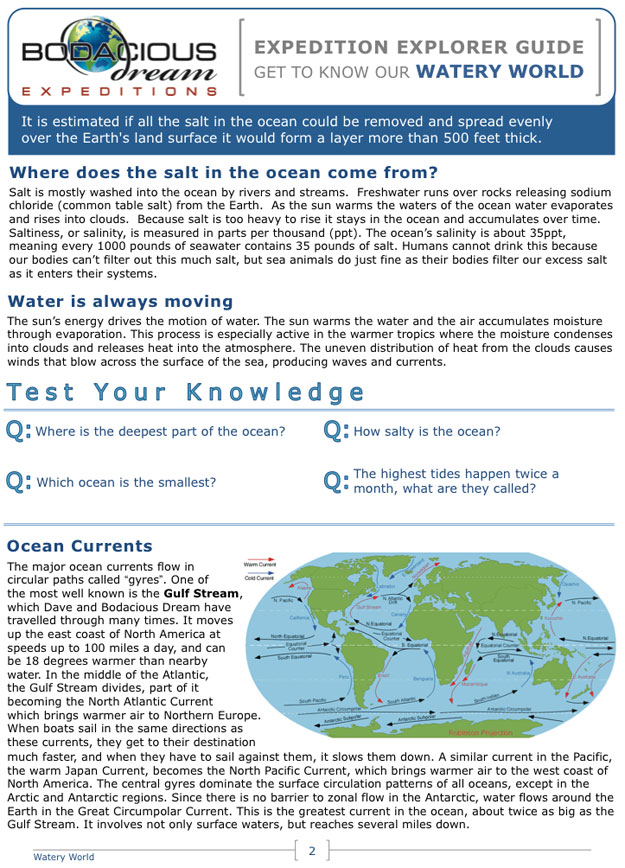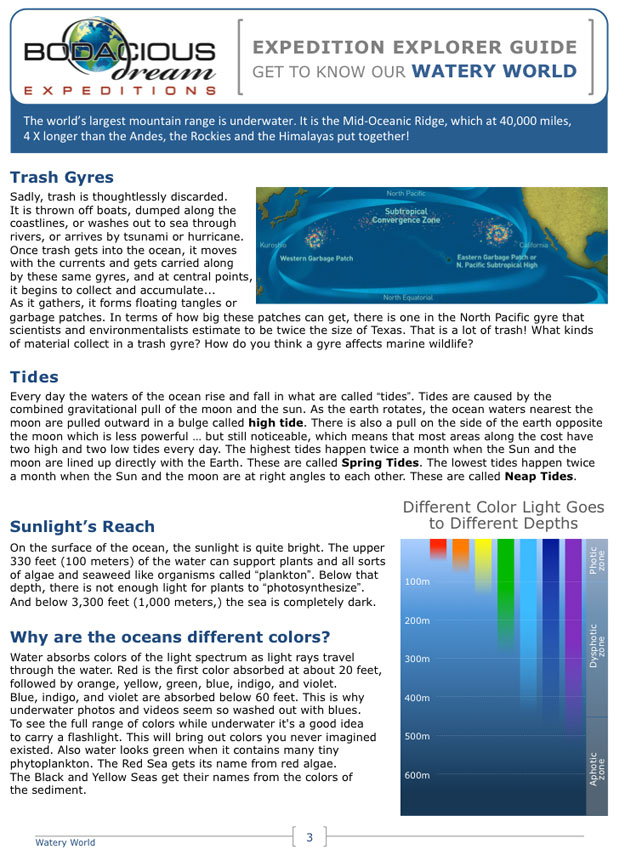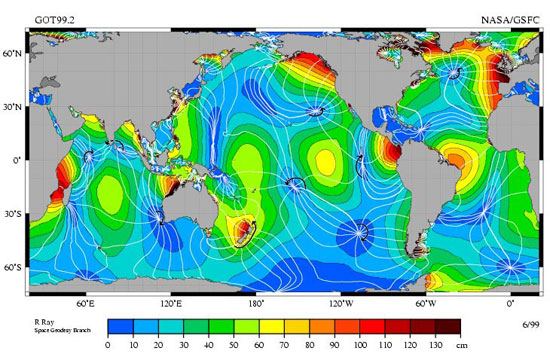4 Pages Here … Scroll Down || (Click here for a print-ready set with both pages!)
:: WATERY WORLD EXTRAS (Beyond what’s in the above Explorer Guides)
Will the water ever go away?
Water moves but it doesn’t go away. Since the beginning, the Earth has held the same amount of water, either in the form of vapor, liquid or ice.
What happens where ocean meets land?
Where land meets sea is called the “continental shelf” and farther out to sea, the “continental slope” and farther out to sea, before it drops off is the “continental rise.” When Bodacious Dream is sailing across these changing areas of the sea floor, sometimes it has effects on wave patterns and currents that can help Dave or can slow him down.
What temperature is the ocean?
Ocean temperatures cover a wide range, Surface waters in the Arctic and Southern Oceans are icy cold. Surface waters nearer the equator, quite warm. The deeper you go, the less effect the rain, wind and sun have on the temperature and it grows gradually colder, until at the ocean floor, the temperature settles to just above freezing.
What about pressure in the ocean?
The weight of the atmosphere presses down on our bodies. On land we don’t notice it so much. In the ocean, as you descend in depth, the amount of water above you increases, causing the pressure on your body to increase. This is why we need special suits (or pressurized submarines) to go into deep water.
At sea level, the air pressure is equivalent to 14.7 pounds pressing down on each square inch. This measurement is commonly called one “atmosphere.” Every 33 feet you go under water increases the pressure one atmosphere. Experienced human divers without the aid of special suits can go around 350 feet of over ten atmospheres. But be careful, even at depths of 100 feet or less, nitrogen in your air supply can have a narcotic and potentially dangerous effect on you by forming bubbles in your blood system.
Does sound travel underwater?
Sound travels much better in water than in air. Some whales can even hear each other from “hundreds” of miles away.
The Major Gyres
 Click the image to get a larger version
Click the image to get a larger version
The Ocean’s Circulation System:
Over most of the oceans (except at high latitudes), a thin layer of warm surface waters overlies the much colder deep waters. The zone of abrupt temperature decrease, as we pass from surface to deep water, is called the thermocline and typically lies between depths of 100 meters (330 feet) to 1000 meters (3280 feet.)
The circulation of the cold water sphere is poorly known. The water is cold because it “originated” in high latitudes close to the poles. The surface waters cooled, sank, and filled up the deep ocean basins. This process is constantly happening, and without it the abyssal (deep ocean) waters would be warm in a few thousand years from the Earth’s heat flow through the ocean floor. If waters sink at high latitudes, they must rise at low latitudes. They do so at an overall rate of about 1 cm/day. Most of the abyssal bottom water of the world ocean “originates” (i.e. sinks from the surface) around Antarctica.
The other important deep water source is the northernmost North Atlantic (the Norwegian Sea and Labrador Sea). This is know from mapping the temperature and oxygen content of near-bottom water, with special, interesting scientific instruments. As the water moves away from its surface source (i.e. as it “ages”) it gradually warms. Also, it slowly loses oxygen because of the respiration of organisms in the deep sea. Thus, “young” water is cold and oxygen-rich, “old” water is less cold and has less oxygen. Most of the deep water in the Atlantic is young, while that of the North Pacific is old.
Sometimes cool water warms which can have devastating effects on the sea life. This change is called El Niño. Depending on the severity, the changes on land can be dramatic too … causing droughts, dust storms, fires in one region, while causing rains, flooding or record snowfalls in another region. These changes are why scientist are so concerned about Global Warming and how it will effect our lives on land in the next 50 and 100 years.
More about the Tides
Another very interesting phenomenon that determines the heights of the tide at any given point of the coastline is its distance from the nearest Amphidromic Points (also called “tidal nodes“) The “tidal range” increases with distance from one of these points – owing to the Coriolis effect and interference within oceanic basins, seas and bays creating a wave pattern, which rotates around the amphidromic point. At the amphidromic points themselves, there is almost no vertical movement from tidal action. (DM: Neat, but perhaps too technical and in depth.)
Now, you see above, that we left you a link to Coriolis Effect. Turns out this very important gravitational phenomenon is not very easy to define. But we came upon a rather simple definition, that we’d like to share. See if it makes the idea clearer to you. By the way, this comes from a gentleman on Yahoo Answers named “Old Pilot” – who has at this point answers 12985 questions. (Hats off to a a great online “mentor.”)
“Think of a merry-go-round that has a toy train that runs straight in from the edge to the center. Start the merry-go-round turning. Now start the train going in toward the center. As the train moves toward the center the circumference of the circle its center of mass is moving in, is growing smaller which means its “tangential velocity” is decreasing. By Newton’s First Law, the rails of the train track must exert a force on the train to slow that tangential velocity. That force is the Coriolis Force.” *Good explanation, but does not adequately explain the relationship between the Coriolis Effect and the most noticeable result which is induced clockwise rotation of high pressure weather systems in the Northern hemisphere and counter-clockwise in the Southern hemisphere.
The Coriolis effect is caused by the rotation of the Earth and the inertia of the mass experiencing the effect. Because the Earth completes only one rotation per day, the Coriolis force is quite small, and its effects generally become noticeable only for motions occurring over large distances and long periods of time, such as large-scale movement of air in the atmosphere or water in the ocean.
What are Tsunamis?
Tides are not the same as tidal waves. Tidal waves (or “Tsunamis”) are caused by undersea earthquakes or volcanic eruptions. It’s possible for these shockwaves to move across the water at speeds up to 500 miles an hour. In the open ocean, a tsunami may only be a few feet tall, but when it hits land, the wave can grown huge and hit with a huge force
What are Waves?
Winds blow across the surface of the ocean, forming little ripples that then grow into waves. The size of a wave depends upon the speed of the wind, how long it blows and the “fetch.” The fetch is the distance over which the wave travels. In the open ocean, waves are all different sizes and shapes and go in different directions. Eventually waves form into groups of similar length. These are called “swells.”
 Waves move across the ocean carrying the energy of the wind, but the water does not move along with the wave. Only the energy of the waves moves forward, even though when you watch a wave hit the shore, it appears that the water is moving … but this is just the effect of the wave dispensing its energy, laying out the height of the wave on the beach. The high spot of a wave is called a “crest” and the low spot is called a “trough.” The distance between two crests or two troughs is called the “wavelength.”
Waves move across the ocean carrying the energy of the wind, but the water does not move along with the wave. Only the energy of the waves moves forward, even though when you watch a wave hit the shore, it appears that the water is moving … but this is just the effect of the wave dispensing its energy, laying out the height of the wave on the beach. The high spot of a wave is called a “crest” and the low spot is called a “trough.” The distance between two crests or two troughs is called the “wavelength.”
Wind creates waves by moving water up and down. A steady wind of 17 mph (27km/h) can whip up 6 foot waves. Wind that blows for two days at 70 mph, can create waves 50 feet (15 m) tall – that’s a 5 story building. Storm-driven waves can build up to great heights. One of the largest ever recorded was 112 feet tall, the height of a ten story building.
As waves reach the shallow water near shore, they change shape as waves farther out to sea come in faster than those in the front are moving, As the waves slow down, the crests of the waves cannot maintain the same speed and so tumble over into the trough in front of them, becoming “breakers” which when the break on shore, become “surf.” Depending on how shallow the shore is, the breakers can break small or huge as they do in areas where surfboarding happens.
In what ways are we and the ocean the same?
 “…It is an interesting biological fact that all of us have, in our veins the exact same percentage of salt in our blood that exists in the ocean, and, therefore, we have salt in our blood, in our sweat, in our tears. We are tied to the ocean. And when we go back to the sea, whether it is to sail or to watch it we are going back from whence we came.” – John F. Kennedy speaking at the America’s Cup in Newport, RI 1962
“…It is an interesting biological fact that all of us have, in our veins the exact same percentage of salt in our blood that exists in the ocean, and, therefore, we have salt in our blood, in our sweat, in our tears. We are tied to the ocean. And when we go back to the sea, whether it is to sail or to watch it we are going back from whence we came.” – John F. Kennedy speaking at the America’s Cup in Newport, RI 1962





